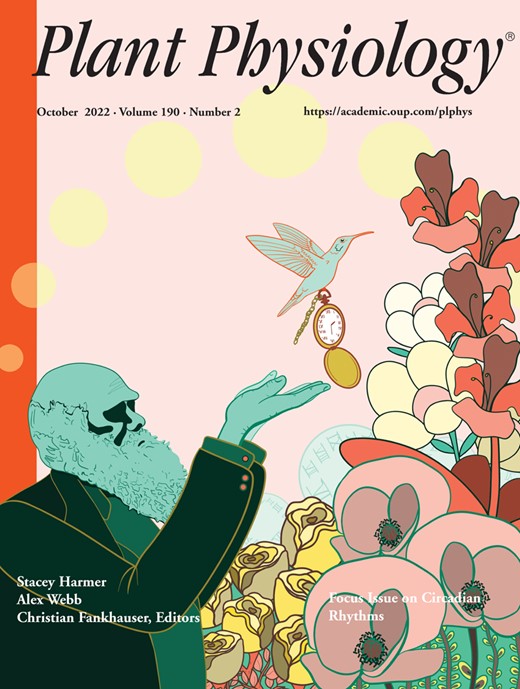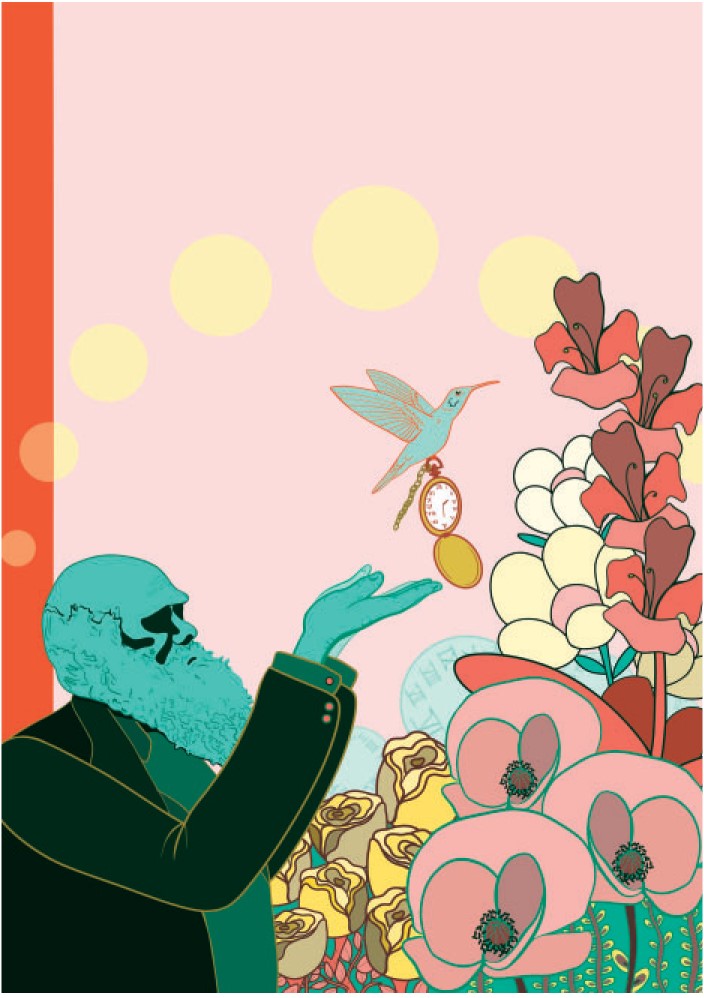
Cover image

Volume 190, Issue 2, October 2022
Focus Issue on Circadian Rhythms
Editorial
Focus on circadian rhythms
Update
Cell Biology
Evolution of circadian clocks along the green lineage
Some homologs of the angiosperm clock are conserved along the green lineage but may exhibit different functions, as observed in a flagellate chlorophyte alga.
Genes, Development and Evolution
Spatially specific mechanisms and functions of the plant circadian clock
Emerging tools and techniques provide insights into how the behavior and outputs of the circadian clock vary across the plant.
Signaling and Response
Plant clock modifications for adapting flowering time to local environments
Crop genes that have been implicated in the modulation of photoperiodic flowering time and adaptation include orthologs of Arabidopsis core clock genes.
The adaptive nature of the plant circadian clock in natural environments
The circadian clock orchestrates the precise coordination of plant processes across daily and annual cycles of light and temperature, resulting in adaptation to local environments.
Circadian entrainment in Arabidopsis
The mechanisms by which circadian clocks adjust to daily rhythms of light, dark, temperature, and internal metabolism are now coming to light.
Breakthrough Technologies, Tools, and Resources
Signaling and Response
CAST-R: An application to visualize circadian and heat stress-responsive genes in plants
CAST-R allows users to visualize circadian profiles, time of day response to heat stress, phase enrichment, connections to the clock, and compare expression profiles between datasets and plant species.
Research Articles
Biochemistry and Metabolism
Multi-omic analysis shows REVEILLE clock genes are involved in carbohydrate metabolism and proteasome function
Proteomics and metabolite analysis shows that the only known activator transcription factor family involved in the plant circadian clock impacts carbohydrate metabolism and proteasome regulation.
Cell Biology
Cellular localization of Arabidopsis EARLY FLOWERING3 is responsive to light quality
Light signaling pathways converge on the evening complex scaffold protein EARLY FLOWERING3 by controlling its cellular and sub-cellular localization and regulating circadian clock gene expression.
Genes, Development and Evolution
Core circadian clock and light signaling genes brought into genetic linkage across the green lineage
The genetic linkage of the core circadian clock and light signaling genes coincides with the rise to dominance of flowering plants and may explain environment-specific growth as well as heterosis.
Signaling and Response
Rice CIRCADIAN CLOCK ASSOCIATED 1 transcriptionally regulates ABA signaling to confer multiple abiotic stress tolerance
A rice core circadian clock component confers broad-spectrum tolerance to abiotic stress by transcriptional orchestration of multiple key genes in abscisic acid signaling.
Regular Issue Content
News and Views
And … cut! Identifying chromatin features affecting CRISPR–Cas9 activity in plants
With a little help from MYB friends: Transcriptional network controlling root suberization and lignification
Consequences of saline-dry conditions to the soil–plant–air continuum
The flow of water: Critical factors of root axial water transport determined
Every breath you don’t take, I’ll be helping you: Ethylene promotes hypoxia tolerance
Sphingolipids: A new piece in the puzzle of insect egg-triggered plant immunity
Letters
Cell Biology
Candidatus Liberibacter asiaticus accumulation in the phloem inhibits callose and reactive oxygen species
CLas inhibits callose deposition in the sieve pores and the accumulation of reactive oxygen species to favor its cell-to-cell movement.
Signaling and Response
Rice catalase OsCATC is degraded by E3 ligase APIP6 to negatively regulate immunity
Research Articles
Biochemistry and Metabolism
Alcohol acyl transferase genes at a high-flavor intensity locus contribute to ester biosynthesis in kiwifruit
Genetic, sensory, and biochemical analyses reveal the importance of three alcohol acyl transferase genes for volatile ester production and flavor intensity in ripe kiwifruit.
Pyruvate, phosphate dikinase regulatory protein impacts light response of C4 photosynthesis in Setaria viridis
Loss of the pyruvate, phosphate dikinase regulatory protein leads to lower initial rates of C4 photosynthesis during the light induction phase of photosynthesis.
Transcription factor CmbHLH16 regulates petal anthocyanin homeostasis under different lights in Chrysanthemum
Plants fine-tune anthocyanin homeostasis in flower petals to adapt to different red/far-red light ratios.
Breakthrough Technologies, Tools and Resources
Epigenetic features drastically impact CRISPR–Cas9 efficacy in plants
Cell Biology
Transcriptional networks regulating suberin and lignin in endodermis link development and ABA response
A SHR-mediated hierarchical transcriptional network composed of multiple MYB transcription factors balances suberization and lignification, integrating stress response, and root development.
Brassinosteroid signaling restricts root lignification by antagonizing SHORT-ROOT function in Arabidopsis
SHR-mediated root lignification is spatially restricted by brassinosteroid signaling through the direct binding of BZR1 to SHR.
ADP-ribosylation factor D1 modulates Golgi morphology, cell plate formation, and plant growth in Arabidopsis
A small guanine-nucleotide-binding (G) protein regulates Golgi morphology, cell plate formation, and plant growth in Arabidopsis by interacting with COAT PROTEIN COMPLEX I components.
Altered properties and structures of root exudate polysaccharides in a root hairless mutant of barley
The root exudate of a root hairless mutant of barley, relative to wild type, has an altered pattern of polysaccharide epitopes and lesser amounts of an acidic soil-binding polysaccharide complex.
Ecophysiology and Sustainability
Coupled effects of soil drying and salinity on soil–plant hydraulics
A physical model interprets transpiration reduction under drought and salinity as a consequence of osmotic gradients at the root surface that cause a severe drop in leaf water potential.
Genes, Development and Evolution
Parasitic plant small RNA analyses unveil parasite-specific signatures of microRNA retention, loss, and gain
Florigen repression complexes involving rice CENTRORADIALIS2 regulate grain size
A florigen repression complex regulates grain size by restricting cell expansion in the spikelet hull and controlling seed filling.
Membranes, Transport and Bioenergetics
Abscisic acid influences ammonium transport via regulation of kinase CIPK23 and ammonium transporters
To avoid abiotic stress by ammonium toxicity, Arabidopsis increases ABA levels, starting a complex phospho-regulation of ammonium transport, including the phosphatase ABI1 and the kinase CIPK23.
Phenotyping and modeling of root hydraulic architecture reveal critical determinants of axial water transport
A model-assisted experimental dissection of architecture and water transport properties of Arabidopsis root systems reveals limiting roles of xylem transport.
Two transporters mobilize magnesium from vacuolar stores to enable plant acclimation to magnesium deficiency
Tonoplast-localized transporters facilitate Mg2+ retrieval from the vacuole for Arabidopsis to cope with magnesium deficiency.
Signaling and Response
A calmodulin-like protein (CML10) interacts with cytosolic enzymes GSTU8 and FBA6 to regulate cold tolerance
A calmodulin-like protein activates glutathione S-transferase and fructose 1,6-biphosphate aldolase to improve cold tolerance in alfalfa.
Loss of function of the bHLH transcription factor Nrd1 in tomato enhances resistance to Pseudomonas syringae
The tomato bHLH transcription factor Nrd1 negatively regulates tomato immunity to bacterial speck disease by suppressing a putative defense-related gene encoding an arabinogalactan protein.
A rhabdovirus accessory protein inhibits jasmonic acid signaling in plants to attract insect vectors
A plant rhabdovirus accessory protein subverts JA signaling of host plants for insect vector attractiveness and efficient virus transmission.
Ethylene augments root hypoxia tolerance via growth cessation and reactive oxygen species amelioration
The early flooding signal ethylene contributes to forthcoming hypoxia stress by modulating a plethora of processes including reactive oxygen species amelioration and growth cessation.
Cold-induced [Ca2+]cyt elevations function to support osmoregulation in marine diatoms
A calcium signaling pathway in marine diatoms is activated by cold temperature and enhances survival during simultaneous hypo-osmotic stress.
A mutant-based analysis of the establishment of Nod-independent symbiosis in the legume Aeschynomene evenia
Characterization of Aeschynomene evenia mutants altered in nodulation provides information on alternative mechanisms of rhizobium–legume symbiosis
Glutathione S-transferase interactions enhance wheat resistance to powdery mildew but not wheat stripe rust
Proteomics and functional analysis showed that TaGSTU6/TaCBSX3 interaction plays an important role in wheat resistance to Bgt.
A KARRIKIN INSENSITIVE2 paralog in lettuce mediates highly sensitive germination responses to karrikinolide
Plants selectively detect germination stimulants in smoke and other butenolide chemicals as a result of evolutionary changes to the ligand-binding pocket of an enzyme-receptor protein.
Class I TCP transcription factor AtTCP8 modulates key brassinosteroid-responsive genes
A member of a pathogen-targeted transcription factor family modulates phytohormone response networks and displays brassinosteroid-dependent cellular location and activity.
A secreted fungal subtilase interferes with rice immunity via degradation of SUPPRESSOR OF G2 ALLELE OF skp1
A secreted fungal subtilase from Ustilaginoidea virens interacts with the positive regulator of innate immunity SUPPRESSOR OF G2 ALLELE OF skp1 to enhance susceptibility to multiple rice pathogens.
DNA hypermethylation promotes the flowering of orchardgrass during vernalization
Vernalization-induced DNA hypermethylation is responsible for floral primordium initiation and development in orchardgrass (Dactylis glomerata).
Transcription factors ZmNF-YA1 and ZmNF-YB16 regulate plant growth and drought tolerance in maize
Transcription factors ZmNF-YA1 and ZmNF-YB16 play positive roles in plant growth and drought tolerance in maize via directly regulating expression of multiple genes.
Systems and Synthetic Biology
Rice co-expression network analysis identifies gene modules associated with agronomic traits
Rice co-expression network analysis identifies gene modules associated with diverse agronomic traits, and these modules provide ample resources for studies on rice trait genes.








































